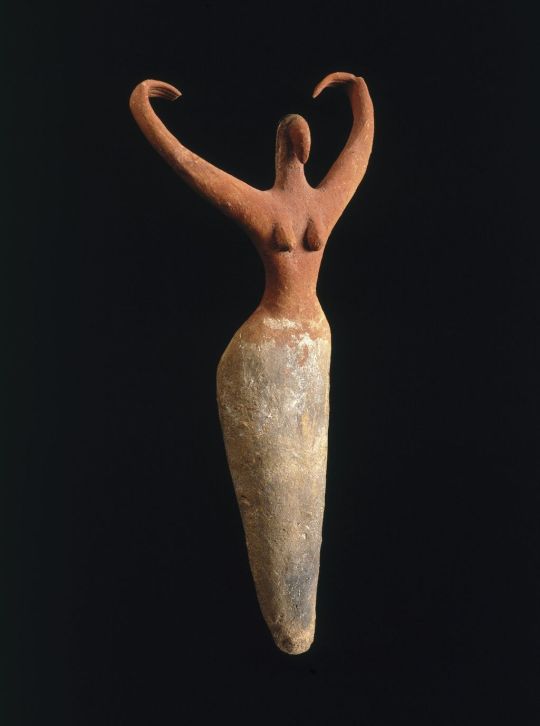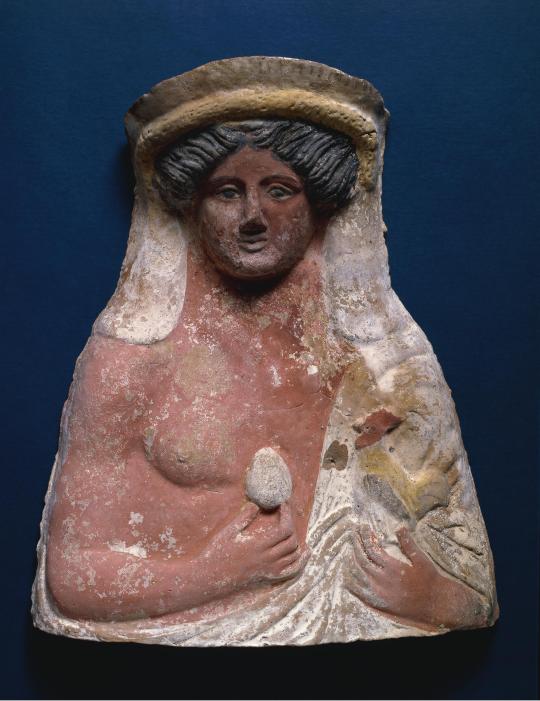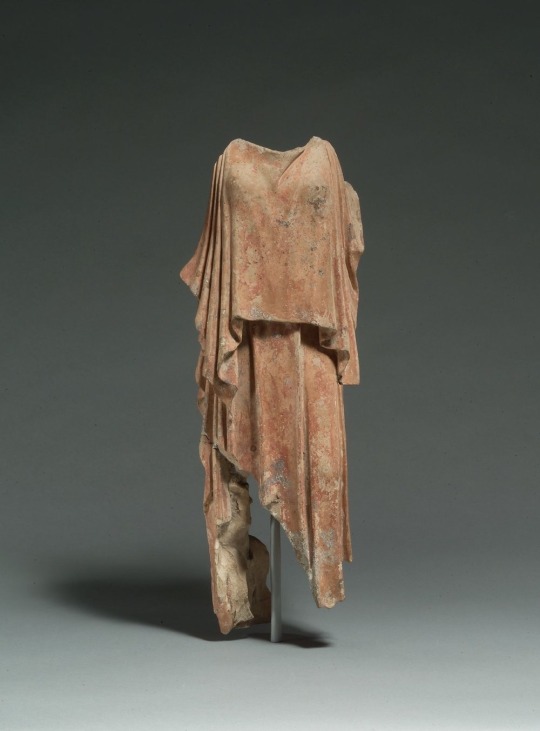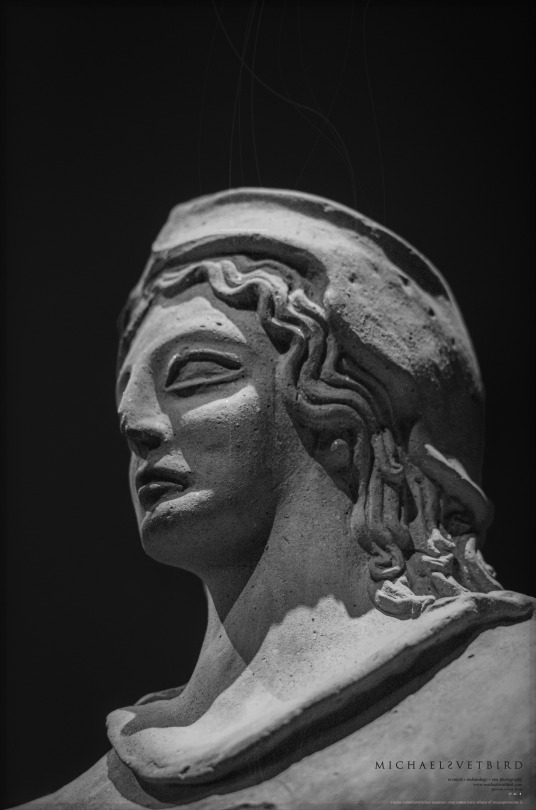#ancient terracotta sculptures
Text

“Sculptural Group of a Seated Poet and Sirens,” Greek, 350–300 BC; terra cotta with ploychromy, also known as “Orpheus and the Sirens.”
J. Paul Getty Museum
The three figures were acquired by Getty himself in 1976.
#orpheus#sirens#antiquities#ancient greek#ancient art#ancient greece#ancient greek mythology#ancient greek art#terracotta#getty villa#getty museum#poet#antiquity#ancient history#greek mythology#greek antiquities#classical art#greek heroes#art#artwork#fine art#art history#sculpture#ancient sculpture#figurative art
268 notes
·
View notes
Text




~ Lamp.
Date: A.D. 1st century
Medium: Terracotta
#ancient#ancient art#history#museum#archeology#ancient sculpture#ancient history#archaeology#lamp#terracotta#1st century
726 notes
·
View notes
Text

Polychrome terracotta sculpture of the god Dionysos, holding an egg and a rooster. The unusual attributes may hint at a connection to Orphism, which held that the first deity, Phanes or Protogonos ("First-Born"), was hatched from a cosmic egg. Adherents of Orphism saw humankind as the descendants of Dionysos (under the name "Zagreus"), created when the Titans devoured the young Zagreus and were then struck by Zeus' thunderbolt. Artist unknown; created in Tanagra, Boeotia (an important center of terracotta production) ca. 350 BCE. Now in the British Museum.
#classics#tagamemnon#Ancient Greece#Greek religion#Ancient Greek religion#Hellenic polytheism#Dionysus#Dionysos#Orphism#art#art history#ancient art#Greek art#Ancient Greek art#Classical Greece#Classical Greek art#Boeotia#Boeotian art#sculpture#terracotta#British Museum
653 notes
·
View notes
Text

woman figurine, terracotta, 3600 bc s
#woman figurine#sculpture#BC#terracotta#ancient Egypt#Egyptian#my post#btw it's not really a Venus as venues we call women figurines from palaeolithic#usually about 50-10 thousand years bc#but when it comes to basic features as well as hypothetical function it may have served I would call it a much later venues:)
2K notes
·
View notes
Note
have you ever seen the Ubaid snake headed figures? they showed them to us in one of my classes and it immediately made me think of your sculptures (that's a lie, first thought was this snake lady is hot and only after several hours I thought of your art)
anyway hi! love your art! boop!
I had not seen these before!

gotta love the hot snake ladies
#with shoulder pads#lol#pottery#ceramics#terracotta#sculptural#sculpture#snake#reptile#historical art#ubaid#ancient art#little dudes#ask#asks
56 notes
·
View notes
Text

Terracotta bust of Dionysos holding an egg and a cock (c.350BC) Boeotia
61 notes
·
View notes
Text

Terracotta figure of a woman, Greek, mid 5th Century BCE
From the Met Museum
#terracotta#sculpture#statue#woman#greek#ancient greek#ancient greece#ancient#art#5th century bce#bce
32 notes
·
View notes
Text

This is one of the only terracotta warriors that was found almost completely intact.
Note the detail on the bottom of his shoe, showing that grip and traction were considered in footwear even 2,200 years ago.
Each life-sized clay warrior was crafted to be completely unique and there are no two terracotta warriors-among the 8,000 total—that are exactly the same.
Shortly after the completion of the tomb in 210-209 BC, it was looted for weapons and burned, causing the roof to collapse, crushing the terracotta warriors.
All the other terracotta warriors that are currently on display were painstakingly restored.
What's even more remarkable is that the terracotta warriors were originally painted in bright colors by skilled artisans.
Unfortunately, when they were exposed to air and sunlight during the excavation in the 1970s, the colors began to curl up almost immediately and disappeared within minutes.
These terracotta warriors were put in place to guard the tomb of the first emperor of unified China — Qin Shi Huang (18 February 259 BC – 12 July 210 BC).
To this day, the tomb has yet to be opened.
According to ancient historians, the tomb contains an entire kingdom and palace in which the ceilings are decorated with pearls to mimic the night sky.
The tomb is also said to contain extremely rare artifacts and has been rigged with crossbows to shoot anyone trying to break in.
To keep its location a secret, the workers were entombed with the emperor.
As described by Han dynasty historian Sima Qian (145-90 BCE) in the Records of the Grand Historian, he mentioned that inside the tomb, "mercury was used to fashion the hundred rivers, the Yellow River and the Yangtze River, and the seas in such a way that they flowed."
Modern tests have indicated extremely high levels of mercury in the surrounding soil.
#Qin Shi Huang#terracotta warriors#Qin Dynasty#China’s First Emperor#clay warrior#Terracotta Army#Mausoleum of the First Qin Emperor#funerary art#Ancient Chinese Warfare#military power#terracotta sculptures#Shaanxi#China
147 notes
·
View notes
Text

Greek female head (terracotta, c. late 4th to early 3rd century BC)
from here
37 notes
·
View notes
Photo

peplos fragment - terracotta - Greece - 5th century BCE
#art by others#other's artwork#drapery#female figure#sculpture#terracotta#ceramic#antiquity#ancient#Greek
277 notes
·
View notes
Text

Woman looking into a box mirror, West Greece, 3rd-2nd century BC, terracotta, MET.
#sculpture#art history#antiquity#ancient greece#greek art#statuette#figurine#terracotta#miror#hellenistic#metropolitan museum of art
193 notes
·
View notes
Text



ATHENA Roccaspromonte:
Italic Terracotta Statue based on the Greek Archaic model,
2nd half of the 4th c. BC [?]
From Roccaspromonte, Campobasso Province, Italy
Found in 1777, acquired by "Antiken-Cabinet", Vienna, in 1815.
"Minerva was originally an Italic deity identified with .. Athena later.
This statue corresponds to the Athena Promachos type, the 'vanguard' and protector in war.
The goddess wears .. Peplos and [her] characteristic breastplate [Aegis] with the [broken off] head of Medusa.
Her arms once held a shield and a lance."
[txt ©KHMV]
KunstHistorisches Museum, Vienna | KHMV
["Ancient Greece and Rome", Kabinett 7]
• Web : https://www.khm.at/en
• FB : https://www.facebook.com/KHMWien
• IG : @kunsthistorischesmuseumvienna
KHMV | Michael Svetbird phs©msp | 13|08|23 6200X4100 600 [I.-III.]
The photographed object is collection items of KHMV, photos are subject to copyrights.
[non commercial use | sorry for the watermarks]
📸 Part of the "Reliefs, Friezes, Slabs, Sculpture" MSP Online Photo-gallery:
👉 D-ART:
https://www.deviantart.com/svetbird1234/gallery/72510770/reliefs-friezes-slabs-sculpture
.
#vienna#kunsthistorischesmuseum#kunsthistorischesmuseumwien#history museum#archaeological museum#roccaspromonte#terracotta#statue#sculpture#ancient sculpture#hellenistic#ancient art#antiquity#ancient#archaeology#archeologia#museology#mythology#art history#history#antiquities#museum#athena#αθήνα#minerva#goddess#archaeology photography#sculpture photography#museum photography#michaelsvetbird
106 notes
·
View notes
Text



~ Lamp.
Date: A.D. 1st century
Place of origin: Knidos, Turkey (?)
Culture: Roman
Medium: Terracotta
#getty#ancient#ancient art#history#museum#archeology#ancient sculpture#roman#ancient history#archaeology#lamp#knidos#turkey#terracotta#1st century
671 notes
·
View notes
Text

Ancient Greek terracotta figurine (16.5 cm = 6.25 in high), depicting a peasant carrying a basket and wearing a pilos (conical cap). Artist unknown; 1st cent. BCE. Excavated at Myrina, Lemnos, in 1883. Now in the Louvre. Photo credit: © Marie-Lan Nguyen / Wikimedia Commons.
#classics#tagamemnon#Ancient Greece#Hellenistic period#art#art history#ancient art#Greek art#Ancient Greek art#Hellenistic art#sculpture#figurine#terracotta#Louvre#Louvre Museum#Musee du Louvre
79 notes
·
View notes
Text



Three terracotta statuettes related to food.
At the top, a Korinthian cheese seller . Made c. 380 BCE in Korinth.
Middle, a moving model of woman making dough. Made c.450 BCE in Rhodes.
At the bottom, a child butchering a pig while, what I take to be a monkey (or a bird?), looks on. Made c. 420 BCE in Boeotia.
#statuettes#terracotta#scenes of everyday life#ancient food preparation#ancient food#ancient greek#ancient greece#ancoent sculpture#ancient pottery#ancientprettythings#original photography
123 notes
·
View notes
Photo

This headless figure from Malta, made of terracotta, is typical of the female figurines discovered throughout Europe. It dates from about 3000 B.C., placing it among the more recent icons of its kind.
125 notes
·
View notes